
Map and GPS track of the entire journey
Private homepage – Hans-Georg Michna
Kenya travel reports: 1999, 2000, 2002, 2003, 2004, 2005, 2006, 2007, 2008, 2009, 2010, 2011, 2012, 2013-Goma, 2013, 2014, 2015, 2016, 2017, 2018, 2019
Kenya Safari Travel Plan, Kenya 1980-2000 photos
Kenya 2013
A personal travel report from Kenya in May and June 2013
Last change: 2014-06-07 – Copyright © 2013-2023 Hans-Georg Michna
Click on the small pictures to see them enlarged, usually to 800 x 600 pixels.
Times are given in local Kenyan time in 24 h format (without "am" or "pm"), i.e. 0:00 to 23:59.
All photos are subject to copyright ©. If you want to reuse any photo, send me an email asking for permission, and I may send you the full-size photo, usually 3,264 x 2,448 pixels (8 Megapixels). These photos bear the copyright © 2013-2023 Hans-Georg Michna.
EXIF times in these pictures should carry proper time and time zone information. Kenya time is UTC + 3 h.
[I finally got a new camera—a Fujifilm HS50EXR. Most photographs in this travel report are reduced to 800 x 600 pixels and JPEG-compressed with medium strength to make them more palatable for the web.]
Warning: Some Kenyan Internet service providers operate a transparent proxy server that shows you obsolete pages. They do that to save money on their international backbone connections, and it is pure fraud. If you suspect that you are getting obsolete pages, your defense is to append an arbitrary query string to the URL. For example, instead of opening http://michna.com/kenya2013/, open http://michna.com/kenya2013/?x=1234, but use a different number instead of 1234 every time. You can use the time of day or any other random string.
My travelling checklist in michna.com/kenya.htm#Preparations (German version michna.com/kenia.htm#Reisevorbereitungen) is, as always, my means of packing without fear of forgetting anything important. As usual, the packing and other preparations take at least a full day of concentrated work, because they cover an immense number of small things and details. Without the checklist I'd be lost.
KLM, Air France, and Kenya Airways on their flights To Nairobi currently allow two pieces of baggage of up to 23 kg each in the economy class. KLM also has a pretty good and informative web site, allowing ticket purchase, online check-in, and often seat selection.
My experience on such international flights, particularly from Nairobi, is that a lot of stress can be taken out of the check-in procedure by being at the airport just 10 to 15 minutes earlier than needed. In Munich the rush seems to begin 90 minutes, in Nairobi two hours before departure. Be there before that rush and everything is a lot more relaxed.
This time I had no safari group with me. Only my wife accompanied me.

Map and GPS track of the entire journey
The itinerary is 7:15 Munich – Amsterdam, 11:15 Amsterdam – Nairobi 20:10 Nairobi time. Our favorite taxi driver will collect us from the airport and take us to the Aero Club of East Africa.
Google Calendar now understands time zones, so we will not have the same problem as last year again. Our phones will show the correct local time and will wake and remind us in time.
Almost as usual, I discovered that I had not done everything in time. I just got a second mobile phone, a Google Nexus One, and noticed too late that I had to reset and reinstall it to make it useful as a backup phone. As a consequence I did not make it to bed before midnight and had only about 4 hours left. I set my mobile phone sleep app to wake me in time, but delay the waking while I was in deep sleep.
Some time after the nominal waking time I turned around in my sleep and thus triggered the waking with bird songs that gently grow louder. This made the waking a bit more bearable than with a classic alarm clock that wakes me with total disregard to my sleep phase.
We got up and drove to the airport very early, before sunrise. The check-in was relatively efficient and reasonably fast. We were separated out from the main waiting line because we already had our boarding passes printed the day before and only needed to drop off our luggage.
We flew from Munich to Amsterdam in an Embraer 190 plane, relatively small, with four seats in each row and one aisle in the middle. This flight also provided us with a breakfast, so the feeling was good in spite of the lack of a full night's sleep.
In Amsterdam we had 2 hours to change planes. In between we sat at a little Internet café and charged our phones. I wanted to try out, for the first time, the new Skype Wi-Fi service. It allows you to link to a cooperating Wi-Fi hotspot and pay by the minute, using your Skype balance. Without Skype Wi-Fi you would have to pull out your credit card and pay for at least half an hour, depending on the tariffs of the Wi-Fi provider.
I chose one of the airport Wi-Fi networks, KPN, and fired up Skype Wi-Fi. Almost instantly Skype showed the price, 14 cent per minute, and offered to connect, which I did. The connection was perfect and very fast. I checked email and a few other things and disconnected after less than 3 minutes. I cannot think of any other way to achieve the same at this price.
With freshly charged phones we boarded the huge KLM Jumbo Jet to Nairobi, which was not completely full. After takeoff people moved around and spread out over the empty places. Ours were good, so we stayed where we were.
The wind seemed to have been favorable, because we flew for long stretches above 1,000 km/h and needed only 7 hours instead of the usual 8. The flight was very smooth. We flew west of Stuttgart, along the Austrian-Swiss border into Italy, along the western coast over water, so we could see many familiar places at the coast. We continued across Sicily, east of Malta, and reached the African coast near Benghazi in Libya.
KLM had surprised us more than once today. First we learned that we can now have two pieces of hand luggage, one normal-sized as before, and another small "accessory", like a small handbag or a camera. Formerly only one piece of hand luggage was allowedallows to look.
Then the woman at the check-in counter offered us to check in a third piece of luggage free of charge, over and above the two permitted pieces. Perhaps she could offer this because the flight was not full or perhaps because she knew that it would be a piece of hand luggage that would be on the flight anyway.
The next surprise is this, quoting from KLM's in-flight magazine:
All electronic devices must be turned off completely while walking to/from the aircraft, and during taxiing, take-off and landing.
So far, so bad. But the next sentences cast a much more pleasant light and break new ground:
The only electronic devices which may be used during the flight and ground stop are:
- Mobile phones, PDAs or other devices with a 'flight' mode or 'flight safe' setting. This must be activated before the aircraft doors are closed.
- Laptops, if the WLAN/UWiFi is turned off.
- Electronic gammes, MP3, DVDE and CD players.
Exceptions apply on one Boeing 777-300ER, which offers Internet on board. …
That's actually two surprises, if you count the availability of Wi-Fi on an airliner as separate news.
Internet pricing is currently approx. €11 for one hour or €20 for a whole flight. It is technically done via a satellite connection.
Unfortunately we did not fly in that single Boeing 777-300ER, in which the new system is currently tested, and did not get Internet on the flight, but the hopes are getting higher.
At least I could now legally record the entire flight, which I did most of the time by sticking the smartphone behind the window shade, then pushing both up, so most of the Window still allowed us to look down and admire our planet.
As I am writing this, the coast of Africa comes into view, always a magnificent sight, with its endless white sand desert. 2 1/2 hours into the flight we are already over Africa and will spend the subsequent 4 1/2 hours above the huge continent until we reach the equator and Nairobi.
On this flight we were too far west to see the river Nile. Instead we flew from Libya into the Sudan near the place where these two countries touch Egypt, then through the Sudan and Southern Sudan, and directly into Kenya.
Our arrival was smooth and quick. Instead of lining up we went to the alternative counter area, which was nearly empty. Our luggage also arrived quickly.
We passed through customs, pulled money out of the ATM and met our prearranged taxi driver Jacob, who took us to the Aero Club of East Africa on Wilson Airport, where I finished writing this report and uploaded it before going to bed after this very long day.
This day was dedicated to various preparations for our actual travels. After a good breakfast we set off to do three things: get more money, go shopping, and go to KWS (the Kenya Wildlife Service) to find out how we can enter Tsavo West and Amboseli through gates without payment facilities.
Everything worked out well. We drove to the big shopping center behind Wilson Airport, bought some stuff like bottled drinking water, and eventually plundered the Barclays ATM. The maximum amount the ATM yields is KSh40,000 and the largest bank note is KSh1,000, so to get KSh160,000 to pay for the car and for lodging, we had to push in our MasterCard four times, each time entering the PIN, going through the menus, entering the amount (the largest amount from the menu is KSh20,000, so we have to go through an extra menu branch to type in the maximal amount), taking back the card, then taking a thick bundle of bank notes and stowing it quickly. The resulting bundle of bank notes is huge, something like 5 cm thick.
Then we drove on to the nearby entrance to Nairobi National Park, where the KWS headquarters are located. We found a very friendly and knowledgeable KWS clerk, who explained in detail how the latest card system works. The system has been modified a few times, so we did not know. Last year we got a different answer, probably because we asked the wrong person.
Contrary to what we heard last year, we can easily obtain a smart card and load money onto it, with which we can enter any KWS park through any gate. The only problems are, and have always been with these cards, that you have to load two different currencies, one for people ($) and one for cars(KSh), that cannot reclaim any money from the card, that you pay for multiples of exactly 24 hours, and that there is no guarantee that a card with a balance on it can still be used next year.
For example, if you paid for 24 hours, but arrive at the exit gate 24 hours plus 1 second later, you have to pay for 2 days, i.e. 48 hours. If you don't have enough on your card, you have a problem. There is no leeway; the card machines are absolutely merciless. You would have to drive to a gate with payment facilities, of which there is only one for each park, load the amount onto your card, then pay with it for the second day.
Then I had an appointment with a specialist doctor for a pilot medical test. Unfortunately the doctor had to travel abroad, and the secretary did not think of informing me. I got another appointment for next Thursday (2013-05-16) and drove back home.
However, there was a terrible traffic jam in my direction. Nothing seemed to be moving at all. So I just drove another way, where there was hardly any traffic, but it was a long detour through residential areas I had never seen before.
Nairobi has a general traffic problem, because it is built between several small rivers, and nobody thought of building enough bridges over these rivers. Now the river banks are all built up with beautiful houses and gardens, but no traffic can get across any of them. This is why one often has to drive long detours to get to a place just across one of the rivers.
But I made it and got back after this interesting sightseeing tour through Nairobi.
In the evening we sat in the club's restaurant on the terrace and chatted with the owner of the aeroplanes I usually fly in Kenya. There are always some good stories to hear or tell.
After a good dinner (vegetable cream soup, chicken wings, etc.) we went to bed early with the plan to rise early the next morning and go on our first trip.
We overslept a little, but as it turned out, we might as well have overslept a little more, because we ended up being early.
How can one be early during a vacation? The cause is that KWS has rigid rules for their pricing. Their prices have gone up year after year, so we have to optimize our times inside KWS parks.
As mentioned above, you always pay for multiples of 24 hours. If you stay for much shorter, you waste your money. If you overstay by a second, you pay for another day. Therefore each trip must be thoroughly and carefully planned. Since we arrive in the afternoon after driving from Nairobi, but must leave in the morning to get back to Nairobi before night, the best way to juggle the times is to spend one night outside the parks, so you leave one park in the afternoon and enter the next one in the morning.
An additional complication is that there is a convoy rule between Tsavo West and Amboseli. You have to leave Tsavo West with one of the three convoys that leave at 8:00, 10:00, or 14:00. Since we have to leave the first park in the afternoon, only the 14:00 convoy was good for us. However, this means that we must not enter the park before 14:00 on the day before. Since we reached the gate in Mtito Andei already at 12:30, we had to kill time there until 14:00, before we could enter the park.
So we went to the Oilibya petrol station, which has a nice little open air restaurant and had lunch there. We knew that petrol station from an earlier visit, when we tried to use their workshop to fix a freewheeling lock(unsuccessfully, because they put it together improperly).
But their restaurant was usable, although one has to be a bit selective with what to eat.
At 13:59 we went to the gate and entered, using our smart card. Unfortunately, the clock in their smart card reader was off by 6 minutes, so we lost another 6 minutes, which would shorten our time for lunch the next afternoon by 6 minutes. Moreover, we had to add a safety margin to all gate times, because we had now learned that those clocks can be imprecise. To the best of my knowledge the clerks at the gates cannot influence these devices. That is their whole idea.
Enough of the technicalities—we entered Tsavo West and drove through a lush landscape, typical for the time after the rainy season. Since Tsavo is bushy, it is difficult to see even large animals if you don't know where they usually are, and our path to the lodge did not lead us through these areas.
Still we saw some dikdiks (very small gazelles) and later a whole family of the rare and shy lesser kudu. I have never before seen these animals so close and for so long, but even so the time was too short to take any photographs. The animals went behind bushes, still good enough to see them, but not good enough for photos, so we just watched them, until they disappeared after a few minutes.
After about two hours we reached the lodge we wanted to try this time, the Kitani Severin Camp. I had stayed there once some years ago and liked it enough for a return visit.
It was still just as beautiful with its nicely designed, spacious tents and has now been taken over by a German company, Severin. We first met the lodge manager, Jürgen, who welcomed us, and later his wife Manya. I can only say that they are doing an excellent job, particularly after I learned that he also trains the cooks, whom we admired for their excellent food.
The quality of this lodge is more typical of the exclusive, high-priced lodges that are far outside our price range. This one is still a little outside our normal price range, but not too far to make a one-time exception.
And so we enjoyed the afternoon and then the evening with a very tasty dinner on the terrace, while looking at some antelopes and giraffes that passed by the illuminated waterholes around the lodge.
The beds in our tent were the best we have had so far on our trip.
In the morning, after a perfect breakfast with fresh mango fruits and many other goodies, we set out to visit Mzima Springs, a place where large amounts of fresh water break out of the volcanic rock and fill a chain of lakes. These are inhabited by fish and hippopotamuses and provide food for crocodiles and cormorants that also live there.
In the first of these lakes there is an underwater tank with windows, like a stranded little U-boat, from which one can peer into the underwater life. We saw lots of fish.
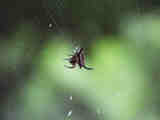
Spiny orb weaver (gasteracantha)
Back in the camp we watched a helicopter take off that had been parked just outside.
After another wonderful, but short meal in the lodge we left quickly towards Chyulu Gate, our exit from Tsavo West in the direction of Amboseli.
Along the way we watched some klipspringers on a lava outflow, very rare animals in Kenya.
We continued past Oloitokitok and after a few more kilometers reached the Amboseli Sopa Lodge, formerly the Kilimanjaro Buffalo Lodge.
This used to be one of the few lodges that have an airfield directly at the lodge, in walking distance. Unfortunately this airfield has fallen into disrepair and is no longer usable. What a pity! The only redemption was the look at the magnificent mountain from the lodge.
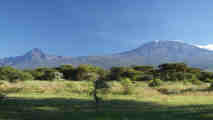
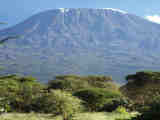
Mawenzi and Kibo, two peaks of Kilimanjaro
We found the lodge nice and functional and can recommend it, particularly for an intermediate stop on the way from Tsavo to Amboseli or vice versa. We had some mobile phone coverage in certain places, even in one particular position in our room.
We did not want to enter Amboseli National Park too early, so we slept long and then had a good breakfast. After that we loaded our car and drove the remaining distance to the Kimana Gate into Amboseli National Park.
All the time we were driving towards the magnificent Kilimanjaro that was out of the clouds in blue sky. It seems that once again the rainy season ended when we came to Kenya in May. This does not mean that it never rains, but the heavy, long rains are now over.
To our surprise this gate has been upgraded to payment capability, and so has the Iremito Gate towards Emali that we had used last year. Conversely, Meshenani Gate, the one pointing towards Namanga, is now no longer a payment gate.
Since the Mtito Andei gate also had payment capability, we could have done this whole trip without obtaining a prepaid card. With the card it was more convenient, but less flexible.
We entered the nature reserve and drove at lower speeds to see the wildlife, particularly the elephants, which you are guaranteed to see in Amboseli.
After checking into Ol Tukai Lodge right in the middle of the park and having lunch, we did a very successful afternoon game drive around the eastern side of the park.
Since we were not primarily looking for large predators, we forwent any early morning game drive and had a good breakfast first. Then we crossed the big Amboseli swamp via the Sinet Causeway and drove into the far western part of the park.
We returned for lunch and later drove out again, this time driving completely along the northern part of the swamp, following its "coastline" along its two branches.
We saw many elephants and other interesting animals. Not all of them could be photographed, but please check the photos and see for yourself.
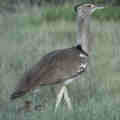
Cory bustard (deutsch: Riesentrappe)
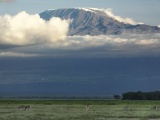
Gazelles in front of Kilimanjaro
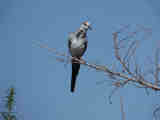
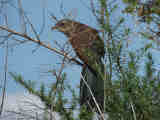
Namaqua dove (Oena capensis); Centropus, a cuckoo
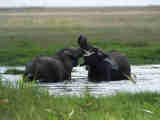
Elephants play-fighting in the swamp
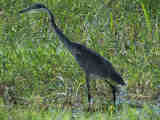
Gray heron (or Goliath heron?)
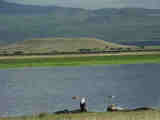
Fish eagle (deutsch: Schreiseeadler)
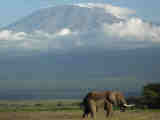
Elephant in front of Kilimanjaro
We got up late, almost missed breakfast, then raced to Meshenani Gate to be there in time. We could not drive through Lake Amboseli, because it was actually filled with water, which is relatively rare. But the normal road around it had been redone and allowed high speeds, so we had no problem at all to reach the gate well in time.
We continued to Namanga on the Tanzanian border, filled our tank, and continued to visit some friends who live between Bissil and Kajiado. Their estate always makes an enchanted impression on me. Too sad that we could not stay for long, but soon had to say goodbye again to make it to Nairobi before dark.
There we checked into the Aero Club of East Africa again and had a nice dinner, before I began to write the new parts of this travel report.
I had a number of things to do in Nairobi, beginning with the renewed appointment at 10:00 with the doctor for a medical examination, required for my pilot license.
When I wanted to drive off, I noticed that the front right tire was almost completely flat, a bit too flat to drive to the petrol station at the entrance of Wilson Airport. So I had to prove to myself that I could still change a wheel in a few minutes.
Then I drove out. To my surprise there was no dense car traffic on my short way, so I was there before 9:30 and stood in front of the locked door again. But soon the secretary came and asked me in. Unfortunately the doctor had called and said that he would not make it before 11:00. I decided to use the time to drive to Rasuls Car Hire & Tours and have the car checked and the tire replaced. We had had a few incidents in which the starter did not engage at the first try and were a bit worried that it could fail completely.
However, I got stuck in a very slow traffic jam on the way to Uhuru Highway, the main traffic artery through Nairobi, something like its spine. After a while I decided that I could not make it in time and turned back.
The doctor came, the examination went well, I received the required paper and now drove to Rasuls. They were, as usual, very helpful. They could not fix the starter quickly enough for my schedule, so they gave me another car of the same type and kept ours there to work on it.
I drove to the international airport with the plan to have a little lunch in the KAA (Kenya Airports Authority) cafeteria, which is in the same building as my destination, the KCAA (Kenya Civil Aviation Authority). The KCAA Licensing Office has a lunch break from 12:30 to 14:00, so I had more time than I needed for my small lunch.
After lunch I went to the KCAA Licensing Office, filled in the required forms and finished the bureaucratic task. Unfortunately they do not issue the renewed license immediately, but in this case told me to collect it not before Monday. I hope that some nice people in the office where I normally rent aeroplanes will collect it for me, so I can meanwhile keep travelling.
I had to drive on to the passenger terminal, because there one can pay the parking fees. They can be paid at the exit gate as well, but only with a 50% penalty. I used the opportunity to plunder the Barclays ATM once more, so we had enough cash for the next part of our trip. Finally I paid for the parking and drove back to town, to the Rasuls office and workshop.
Meanwhile they had fixed the tire and the starter, so I swapped cars again and drove back to Wilson Airport and the Aero Club for dinner.
My next task was to fix a Google-Samsung Nexus S phone that I had given to a friend. This type of phone, in its standard software configuration, could not display the SIM Tool Kit, which is very important in Kenya for the mobile payment system M-Pesa.
I rooted the phone and changed to the CyanogenMod 10.0 Android version, which has no problems showing and using the SIM Tool Kit, which made my friend very happy.
So much for this work day. But even this day helped to acclimatize, get used to the Nairobi city traffic, and enjoy the beautiful summer-like weather. The top temperatures in Nairobi were about 24 to 25°C with the lowest in the early morning being 13°C. We have not had any rain.
The distance from Nairobi to Nakuru is 160 km and can be driven in about three hours, including some Nairobi city traffic. Therefore I was not in a hurry, but had some time instead to test the reprogrammed smartphone and for a nice breakfast.
We left around 10:30 and drove right through the center of Nairobi, Uhuru Highway. At this time of a Friday the traffic was relatively light. We spent only about 20 min in traffic jams and soon sped along the highway to Nakuru.
Apart from one stretch just outside Greater Nairobi that had some potholes and a damaged surface the road was excellent, so we drove at around 70 km/h, which is near our limit for this kind of car and traffic.
Google Navigation is now newly enabled for Kenya, so we tested it on this route. It failed once, just before reaching Nakuru, and behaved as if it did not know the main road. But after we ignored all bad advice to leave the road, it quickly came to its senses again and led us on a very good and simple route to our hotel.
There is still no traffic information. Apparently Google switches the functions on one by one after some testing and after enough people with smartphones feed it with useful data.
We arrived around 13:30 at the Nuru Palace Hotel, a fundamental-Christian-run outfit with a good performance-price ratio, but no alcohol.
When we entered, we saw that the hotel had been taken over by a company outing. A biggish roof-building company was holding an employee conference with about one hundred participants.
Most rooms were already taken, but we were offered an executive suite for €50, which we gladly accepted.
We went to the restaurant on the hotel compound and had chicken for lunch. After that we retreated into our suite, and I finally found the time to continue to write this travel report.
In the evening we met a friend for dinner, before we finally retreated into our suite for the night.
It is not very far to Baringo, so we did not have to wake up too early. We ended up being the last breakfast guests in the restaurant, after we had already moved our luggage into the car.
After breakfast we drove out of Nakuru, properly guided by Google Navigation, which we were still testing. Traffic was light, but at times we had the feeling that we spent more time negotiating speed bumps than for normal driving. But with two people constantly watching out for the nasty bumps, we did not overlook even one.
The view from the high road was beautiful. As we were driving along the Rift Valley, approximately in the middle of it, we could often overlook the whole area either left or right to the edge of the Rift Valley, which loomed high in the distance. Then we crossed the equator.
Along the way I sent emails and text messages to the people we were going to visit, to inform them about our progress.
We had already experienced a few petrol stations that had run out of fuel, so we worried a bit about keeping our tank full. We would need a nearly full tank for our next trip, so we stopped at the first station in Marigat and took 5 l to fill up our tank again.
As we got further north and eventually descended into the Lake Baringo area, the temperature steadily rose, until we reached some estimated 30°C and drove with at least one window completely open to keep ourselves somewhat cool.
We arrived at a gate, where the local district collects a kind of customs fee (probably illegally) from each visitor. 9 young men stood at the gate and chatted, while an older officer sat in the little booth with his registration book.
Most of the guys knew me and greeted me. When the official attempted to collect his fee, they all protested and told him that I was an old friend of several people in Baringo and that he should let us through without payment. As they lambasted and frustrated him, he suddenly shut his book and told me to go through. We quickily drove past the barrier and turned into the road to Roberts Camp.
Our immediate destination was the "Thirsty Goat", the pub and restaurant of the camp and banda (hut) site, where we sat down for a drink.
I could not trust my eyes, when I saw the lake's water level. It was only about a meter lower than the Thirsty Goat terrace, and most of the bandas, along with the main house of the Roberts family, were now in the lake, with the water above floor level or, for the main house and some others, near roof level.
10 m from my position in the Thirsty Goat there was a temporary, movable jetty with three boats in the water, and a crocodile slowly swam along the shore in front of one of the drowned houses.
Many trees cannot survive in the water. They die and eventually fall. The people who run the camp site have been doing an incredibly hard job of salvaging whatever possible from the buildings and felling the dead trees. They will be turned into charcoal.
In the evening we visited friends.
We felt like catastrophe tourists when we entered a boat and moved along the shore and to the houses that were now in the lake and flooded. Some of them had the ground floor completely under water.
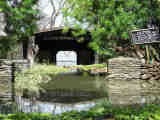
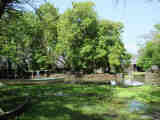
Lake Baringo Club from the land side
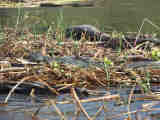
The crocodiles find new hideouts.
Lake Baringo has more than 500 recorded bird species. Some are shown here, along with some other animals.
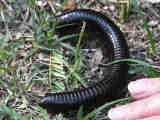
Mombasa train, a large millipede

Fish eagle (deutsch: Schreiseeadler)
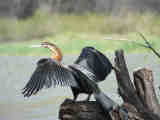
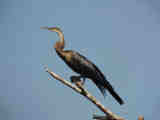
East-African darter, a cormorant subspecies
In the evening we prepared for our next trip, the longest drive on our tour.
The distance we had to cover on this day was 290 km, but the achievable average speed may only be 25 km/h. Since we wanted to arrive before dark, we had our alarm clocks set to 5:00 and planned to drive out at 5:30. We did not quite make that, but were rolling out at 5:50, when the first signs of dawn were just barely visible.
We drove along the last bit of paved road north to Loruk and now already had some daylight, when we turned off the road onto the track leading to the east around the northern shore of the lake.
Soon thereafter we could switch off the headlights and saw the sun rise directly before us in some places. As we climbed out of the Rift Valley in giant steps, we were often driving in the shade of steep cliffs or in front of the next ridge. When we reached the highlands to the east of the Rift Valley, the sun was already high enough for us to see well with the sun shades lowered.
Our route was Baringo – Loruk – Tangulbei – Churo – Mugie – Sukuta lol Marmar – Kisima – Lodungokwe – a few km before Wamba – Turnoff into the West Gate Community – Ngutuk Engiron school – Samburu West Gate – Samburu Lodge.
We took on a hitchhiker, a Pokot woman with a baby. She was very fearful, but still climbed into the car. She did not look at us and did not answer questions we asked in English. She only said, "Tangulbei".
In Tangulbei I asked her whether she wanted to exit the car. She nodded and made futile attempts to open the car door. So I opened the door for her. She exited, and then spoke her first and only English words, "Thank you."
Most of the distance could be driven in third gear, quite a bit in second and first gear, and some stretches could be driven in fourth gear at 50 km/h according to the tachometer, translating into perhaps 45 km/h true speed. In the whole distance I tried to shift into fifth gear twice, but both times had to brake very soon thereafter and shift back down into some lower gear.
So I gave up trying to go faster than 50 km/h, because at higher speeds I would have been unable to brake quickly enough before the ever-present ditches, washed out by earlier rainfall. Particularly around noon, small depressions were difficult to see in time, so any higher speed was out of the question.
After we had passed Lodungokwe in the afternoon, a grading machine worked its way towards us, grading the road. This was our luck, as we could now drive the freshly graded part of the remaining distance at 50 km/h.
In the end our average speed, not counting a few short stops, was 28 km/h, so we had covered the distance in about 10 h 15 min and arrived in the lodge some time before dark.
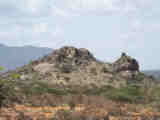
Buffalo head in the Wamba area

This is what my shirt looked like after the drive.
We were exhausted, went to bed immediately after dinner, and immediately fell into deep sleep.
The next morning we woke up after a long night's sleep in very good shape, particularly enjoyed the breakfast, but also all other meals, the company of John, the giraffe researcher, and the wonderful nature, particularly the wildlife, which we could see from the lodge. We did not find the time to drive out. Instead I brought this travel report up to date for the benefit of the near-real-time readers.
We had a wonderful time in Samburu. It is the nature reserve in Kenya that has a very typical climate and vegetation for central Kenya and is not as high and cool as, for example, Masai Mara. The soil is sandy, and there are some palm trees, mostly doum palms, near the river. Some photos:
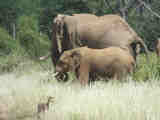
Size comparison: dikdik, elephant cow, elephant bull
We also visited Shivani, the lion researcher, in her remote camp outside the West Gate. It takes us an hour and a half to get to her camp site and the same time back, so it is already a major undertaking. But the information and the stories we get in return always make a visit worthwhile.
I got up early and did a short early-morning game drive.
After breakfast we checked out and left for Thika. Along our way we reached the Nanyuki Civil Airport, just next to the road, with its highly regarded restaurant "Barney's". They are under new management and now have a pizza oven. I tried it and found the pizza to be excellent, not too different from genuine Italian pizza.
We continued towards Thika, where we wanted to visit the daughter of a friend. She attends a boarding school, the Maryhill Girls' High School, which we believed to be in Thika. When we searched for the school in Google Maps, we got two hits in the center of Thika, not very far from each other. So we continued to the most likely-looking one, only to find that there was no school anywhere to be seen.
The second one led us into an area with very narrow streets that did not look as if it could contain any school, so we had to give up there too. We started asking people for the school, but got differing answers.
I remembered a third Google Maps hit that was not located in Thika, but 10 km to the west in another district. After three different people we asked also indicated that the school was somewhere in that direction, we navigated there and indeed ended up at the school entrance at 18:00, an hour later than planned.
We drove up to the gate, where two security officers told us that we could not visit any student now, because that is possible only on parents day. And visits are not allowed anyway after 18:00.
We tried to explain that we had come from very far away and had only one chance to see the student. I asked them whether they could not simply call the student to the gate, so we could talk to her. They refused. I told them that I had thought that this is a school, not a prison. That made them think, but apparently they had strict rules to follow and were in no position to make any exceptions.
We called her mother, who called the head teacher, who had already left the school, then called us again, talked to the security officers over the phone, etc. After a series of such telephone calls the security officers told us to come again tomorrow at 8:00. We had no choice but to agree.
So we drove back to Thika and checked into the Blue Post Hotel, probably the best hotel in town, actually located directly at one of the ramps of the Thika – Nairobi "super-highway".
The hotel was bearable. We had dinner in its restaurant, overlooking its big garden and the Thika waterfall.
We got up soon after 6:00, packed our luggage into the car and had breakfast in time to meet the 8:00 deadline at the school.
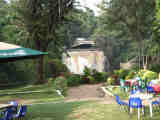
Blue Post Hotel garden and waterfall
Then we drove to the school again. There was only one security officer there, a different one. After we told him that we had an appointment with the head teacher at 8:00, he opened the gate and told us to drive in.
Now everything was much simpler. We drove through the huge compound and ended up on a central square, where we parked our car. Several students were running around, and Zakia, our 16-year-old friend, was already there and awaited us. Nobody else asked us anything.
We found the head teacher, with whom we had the appointment, and talked to her as well. Finally we could chat with Zakia, learn more about the rules of the school, and Zakia showed us around and showed us her classroom and other buildings.
The rules of the school seemed extremely strict to us. For example, when a student had to move from one building to another while not carrying anything heavy, she had to run, not walk, which explained why we saw so many running students.
One of the rules we had reservations about is that the students go to bed around 23:00, but are woken up at 4:30. It seemed to us that they might not be getting enough sleep. Zakia confirmed that she sometimes has difficulties to stay awake during classes.
Our general impression was that the school resembled English boarding schools, as they were typical quite some time ago.
After we had chatted and seen parts of the school compound for an hour and a half, we eventually said goodbye and left for Nairobi, where we had planned to visit another friend and his family, who had just moved to the western side of the city.
We let ourselves be guided by the GPS coordinates of his new home in combination with Google Navigation. While we were entering and crossing Nairobi, I was very impressed with the new roads that had been built, extending the Thika freeway and splitting it up, so the incoming traffic would not be stopped at any bottlenecks on that side.
The Nairobi – Thika super-highway is already impressive. In some places it has 12 lanes, but it still has some speed bumps in some distance from the city, where apparently the money had run out to build more bridges for pedestrians.
We crossed the city in no time, and Google Nav directed us exactly to the gate of the appartment complex where our friends live.
We went into the appartment, which was much more spacious and nice than the old one on the south side of Nairobi. Then we all drove to the Aero Club of East Africa for a good lunch.
Later in the evening I found the time to continue writing this travel report, but soon went to bed, because tomorrow's drive would be long and take the whole day.
We loaded our car and were ready to leave before breakfast, then went to the restaurant for an early breakfast not long after 6:00.
Then we threw ourselves into the Monday morning traffic. We tried Google Navigation again and found that it also chose the way we had intended to take, via Mbagathi way, Ngong Road, Dagoretti Corner, then cutting through northern Nairobi to the main road to Naivasha and Nakuru.
It worked surprisingly well. In only half an hour we had already left Nairobi behind. Of course there were the usual terrible traffic jams in the other direction, caused by people trying to get to their Nairobi city workplaces.
Shortly before the end of the four-lane freeway Google Nav hiccupped and seemed to assume that our freeway was unpassable. The same thing had happened to us on our earlier trip shortly before Nakuru. It means that you cannot entirely trust the navigation just yet and have to have a second means to double-check the route. In our case this was just our memory, but somebody who does not know the place should use my track collection or a paper map for routing sanity checks.
The rest of the routing was perfect, even deep into the nature reserve, right up to our destination lodge.
We turned off the highway to drive on one of the most scenic routes down into the Rift Valley, to Mai Mahiu, where we filled our tank as a precaution.
In this town on the bottom of the Rift Valley on the very eastern side the road continues to Naivasha, but we turned off to the left to cross the Rift Valley. With the volcanos Mt. Longonot to our right and Mt. Suswa to our left we drove towards the other side of the valley, driving over the foot of Mt. Suswa.
After 50 km we reached the western edge and began our climb out of the Rift Valley in several steps. The road was nearly excellent, with climbing lanes wherever the ascent was steep, so we could proceed at our high speed of around 70 km/h with interspersed slow segments when the road went steeply uphill.
We reached Narok, something like the capital of Maasai land, at 10:00, filled our tank once more with about 6 l of petrol, used the marginally usable toilets, bought a mandazi (a little snack), and carried on around 10:30.
Not far after Narok the road to Masai Mara turns off. In spite of some potholes it could still be driven at high speed, but all too soon the good times were over. Now we had to continue on a dirt road.
The first few km had recently been graded and could, to our joy, still be driven at 50 to 70 km/h. But our hopes that this would continue up to the nature reserve were soon squashed, when the road changed into the rocky path that could in many parts be driven only at 15 km/h without fear of breaking the car and our nerves. The shortest distance took the longest time, around 3 hours.
To illustrate the hardships, we had not only to cope with the rocky and very rough road surface, but also with dust clouds of oncoming traffic and with our own dust cloud that kept overtaking us whenever our speed went below 30 km/h, and that was often, because we had an unpleasant tailwind of over 20 km/h. The tailwind also meant that despite completely open windows we had often no cooling air flow in the car, while the high sun burned down relentlessly.
My left arm received a lot of training, because I had to drive much of the distance with my right arm down on the seat to prevent single-sided sundburn. I might have rolled down my sleeve, but that would have increased my dehydration process and taken me one step closer to heat stroke, if you accept the slight exaggeration.
For every oncoming or the occasionally overtaking car we had to switch off the ventilation, crank up both windows, and let go of the accelerator to save the engine some dust intake.
But all this is part of the African adventure. After reaching the elephants and lions, the hardships are soon forgotten and fade quickly in our memories.
We reached Sekenani Gate at 13:45, paid the entrance fees, and continued into Masai Mara, the crown of the Kenyan nature reserves. Immediately we were received by a group of about a dozen elephants crossing the road and stopping us, even having us reverse a short distance, so as not to hinder their movement.
Then we left the rocky road and drove on smaller, sandy car tracks right through the seemingly endless, hilly grass savannah. For navigation I could choose between my own, big track collection and Google Maps with its satellite image overlay. I ended up mostly using the latter, because my track collection is still far from complete, and Google's satellite imagery showed many more tracks, looking more like a complete map of the area.
In the high grass we did not see many animals. Either the animals are smaller and completely invisible or they avoid the high grass as well as they can, because here they would not see a stalking predator. Still the drive was beautiful and relaxing. I like this savannah landscape with its interspersed bushy creeks and hills a lot.
Around 15:30 we reached Fig Tree Tented Camp, our destination. The lodge, one of our favorites, with a capacity of at least 150 guests, had only four guests, a couple from Dresden, who had booked a little safari before attending a wedding in Nairobi, and a young Danish couple from Berlin. This means a reduced food variety, but it also means a family-like setting with many more lodge employees than guests. Since we are regulars here, most lodge employees greeted us enthusiastically.
Given the choice of a hut or a tent, we always choose the tent, because we like to hear the sounds of the African night, most prominently the calls of the lions and hyaenas.
We chose between sleeping long, having a late breakfast, then driving out to the wildlife and early-morning drives, followed by the breakfast. The early-morning drives show some nocturnal animals that disappear during the day, like eating lions, the spotted hyaena, or the elusive bat-eared fox. If you don't find any photos of some of them, that is because we have either not seen them this time or we could not take a good photo.
On some days we then drove out again after breakfast. The hottest time of the day, the early afternoon, is reserved for relaxing, unloading and selecting photos, and writing this travel report. Finally we drive out around 16:00 until sunset, when the light is good for photography.
The night photos were taken inside the lodge.
We had ordered lunch packs from the lodge and set out for a day-long drive through the northern part of Masai Mara to reach Mara River.
Just when we started, our left window failed and could only be cranked up with a helping hand, so we tried to have it repaired in Talek town, the only human settlement along our way, just outside the nature reserve.
The repair man in Talek town could indeed repair the window, but it did not even last one day. We will probably not try another repair, but will instead close it by pushing it in the right direction while cranking.
Photos from the trip:
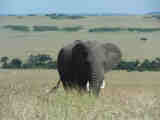
Elephant in the grass savannah
Back in our camp, we kept doing early morning, late morning, and evening drives.
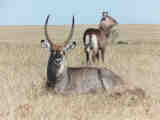
Waterbucks (Photo: Inge F. Michna)
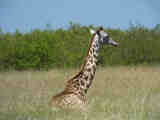
Maasai giraffe, resting on the ground
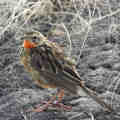
East-African red-throated ground robin
(No, I do not really know the name of
this bird.)
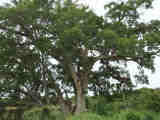
Strangler fig, the tree that gives Fig Tree Camp its name
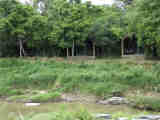
Some tents of Fig Tree Camp, photographed from the other side of Talek River
We left Fig Tree Camp after the earliest possible breakfast and drove a newly possible route through a reopened area in the east of the nature reserve, leading fairly directly to Sekenani Gate.
Our tank was only less than a quarter full, so we needed at least a few liters of petrol to be on the safe side. Since Fig Tree did not have any petrol, we stopped at the Sarova Mara Lodge, which has a petrol station, and filled our tank. At KSh130 per liter the price was about 13% higher than in Nairobi, but still much lower than in Germany.
If you ever think of taking fuel there, you have to obey the opening hours, which are usually those when the lodge generator is running, as most petrol pumps do not work without electricity.
We left the nature reserve through Sekenani Gate and first had a three-hour drive over the gruesome rocky track much of the way to Narok, until we finally hit the paved road.
The rest was easy, though still time-consuming. We risked to drive straight through the city, because the traffic into Nairobi seemed to be light. Indeed we coulde drive all the way almost non-stop. Perhaps the public holiday, Madaraka Day on the 1st of June, helped.
We woke up a couple of minutes past 4:00. Everything went smoothly. Our taxi driver was there at 4:45, and at 4:55 we drove out from the Aero Club.
At this time of the day there was not much traffic, so we arrived at the international airport earlier than we needed to, which made the whole experience nearly stress-free.
We spent some time in the café, having a little breakfast, then we went through the second security check at the gate.
The aeroplane was a Kenya Airways Boeing 777, a modern and quiet plane with comfortable seats and a fairly well-working entertainment system. We soon boarded the plane and lifted off for the long flight over Lodwar, Khartoum, the island of Crete, Greece, later past Graz and Linz in Austria and Regensburg in Germany, to Amsterdam.
The next flight was with an Embraer 190, a much smaller plane, back to Munich.
The surprise was that, when we curved around an area east of Munich before landing, I saw many flooded fields and houses. It was raining and, as I later learned, had been raining the whole time while we were in Africa.
But my magic will surely work, just as it had worked when I arrived in Kenya. When I fly into a place, it stops raining there.
If in this text you find any typos, orthographic errors (even small ones), ungrammatical sentences, wrong or illogical information (like wrong names of birds), if you want me to write more details about something in particular, or if you want one of the photos in full resolution (usually 1,600 x 1,200 pixels), please click on the email sign below and write to me. Many thanks!
Copyright © 2013-2023 Hans-Georg Michna.
Private homepage – Hans-Georg Michna
Kenya travel reports: 1999, 2000, 2002, 2003, 2004, 2005, 2006, 2007, 2008, 2009, 2010, 2011, 2012, 2013-Goma, 2013, 2014, 2015, 2016, 2017, 2018, 2019
Kenya Safari Travel Plan, Kenya 1980-2000 photos
hits since 2013-05-01
Free PHP scripts by PHPJunkYard.com